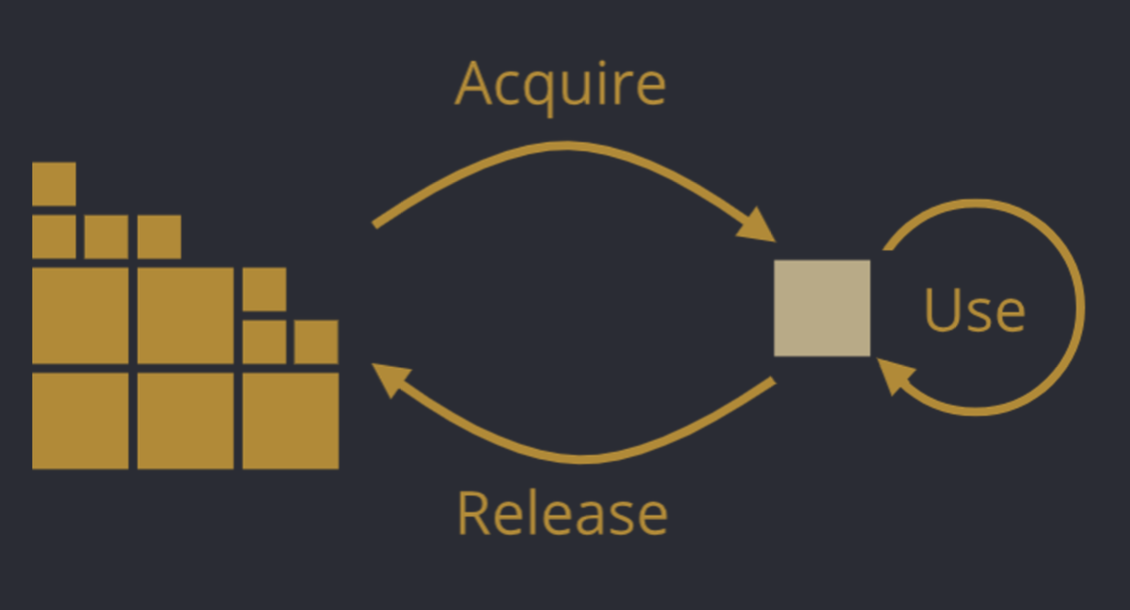Rust - A memory-safe language
About resource ownership
Why does C++ have a const keyword?
Type systems for safety
- Type modifiers such as
constcan prevent mistakes without runtime overhead- Sometimes
constis even faster than non-const!
- Sometimes
constis about mutability: When is something allowed to change?- Rust introduces borrow checking: Who references a resource?
- To understand it, we need to understand resource ownership
Resource lifecycle
- Systems programming is about managing (hardware) resources
- Every resource undergoes the resource lifecycle:

- How do we ensure this lifecycle?
Resource ownership
- Every resource must have at least one owner
- The one responsible for releasing the resource back into the resource pool
- Resources that do not get released leak
- Keep leaking resources and you encounter resource exhaustion
- Kind of like the environment…

Why is resource exhaustion a bigger problem for systems programming than for applications programming?
Resource ownership strategies
- Manual: C, C++ (
malloc,free,fopen,fcloseetc.) - Managed at runtime: Java, Python, Go (garbage collection)
- Managed at compile-time: Rust (borrow checking)
Revisiting invalidating iterators
- This didn’t compile with:
cannot borrow `v` as mutable because it is also borrowed as immutable- Rust borrows are similar to C++ references
- Translation: “You must not change (mutate) something while someone is looking at (borrowing) it”
The rule of one
- Rust values have exactly one owner
- This is limiting, so we can borrow values
- Immutably:
&T - Mutably:
&mut T
- Immutably:
- These are mutually exclusive
- Either exactly one mutable borrow
- Or arbitrarily many immutable borrows
Why the code didn’t compile
- Take an immutable borrow here
Why the code didn’t compile
- Take an immutable borrow here
- Now mutable borrows are disallowed
- Signature of
Vec::push: fn push(&mut self, element: T)
- Signature of
Understanding borrow checking - 1
Compiles or doesn’t compile?
Understanding borrow checking - 1
Doesn’t compile:
cannot borrow `v` as mutable because it is also borrowed as immutableUnderstanding borrow checking - 2
Compiles or doesn’t compile?
Understanding borrow checking - 2
Doesn’t compile, but for a different reason:
missing lifetime specifier
this function's return type contains a borrowed value, but the signature does not say whether it is borrowed from `arg1` or `arg2`Lifetimes
- Lifetimes are generic types that tell the compiler two things:
- How long a specific borrow lives
- How it ties to other borrows
- Translation: “
firstreturns a borrow that comes from botharg1andarg2and lives as long as botharg1andarg2” - What does that even mean?
Lifetimes visualized
fn first<'a, T>(
arg1: &'a Vec<T>,
arg2: &'a Vec<T>
) -> &'a T {
&arg1[0]
}
fn main() { // 'm (lifetime of main) ------
let mut vec1 = vec![1, 2, 3, 4]; // |
let mut vec2 = vec![1, 2, 3, 4]; // |
let p = first(&vec1, &vec2); // |
// |
vec2.push(41); // |
println!("{}", p); // |
} // --------------------------------------Lifetimes visualized
fn first<'a, T>(
arg1: &'a Vec<T>,
arg2: &'a Vec<T>
) -> &'a T {
&arg1[0]
}
fn main() { // 'm (lifetime of main) ------
let mut vec1 = vec![1, 2, 3, 4]; // |
let mut vec2 = vec![1, 2, 3, 4]; // |
let tmp1 = &vec1; // |
let tmp2 = &vec2; // |
let p = first(tmp1, tmp2); // |
// |
vec2.push(41); // |
println!("{}", p); // |
} // --------------------------------------Lifetimes visualized
Lifetimes visualized
Fixed code
Inferred lifetimes
- We only need manual lifetime annotations in ambiguous situations
- Often, the Rust compiler can figure things out for us:
When to add lifetime annotations
- When borrows are ambiguous:
- Borrows inside
structandenum:
When to add lifetime annotations
- When borrows are ambiguous:
- Borrows inside
structandenum:
More on borrow checking once we talk about memory